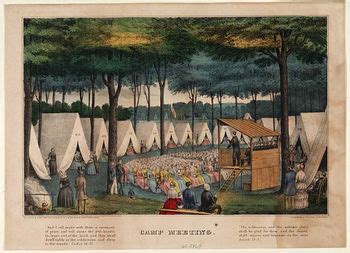Introduction

The Second Great Awakening was a period of religious revival and social reform that swept across the United States from the late 18th to the mid-19th centuries. Marked by a surge in emotional conversions and a proliferation of evangelical Protestant denominations, the movement had a profound impact on American society, politics, and culture.
Origins and Context
The Second Great Awakening emerged amidst a complex web of social, economic, and religious transformations. Frontier expansion, urbanization, and the rise of industrialization disrupted traditional communities and values. Simultaneously, the Enlightenment and Rationalism movement challenged established religious institutions and practices.
Key Figures and Denominations
- Jonathan Edwards: A Puritan minister whose fiery sermons ignited the First Great Awakening.
- George Whitefield: A charismatic British evangelist who preached to vast crowds.
- Charles G. Finney: A Presbyterian minister known for his revival techniques and emphasis on personal conversion.
- Baptists: The largest Protestant denomination during the Second Great Awakening, known for their belief in believer’s baptism and local church autonomy.
- Methodists: A Wesleyan denomination that emphasized personal piety, social justice, and the spread of the gospel.
Religious Beliefs and Practices
The Second Great Awakening was characterized by an emphasis on:
- Emotionalism: Personal and intense religious experiences, including conversions marked by weeping, jerking, and speaking in tongues.
- Salvation: The belief that individuals could be saved from sin through faith in Jesus Christ.
- Conversion: A radical change in one’s spiritual life, often accompanied by a public declaration of belief.
- Revivalism: Mass meetings and preaching events designed to awaken religious fervor.
- Itinerant Preachers: Traveling ministers who spread the gospel in remote and frontier areas.
Social Impact
The Second Great Awakening had a significant social impact:
- Religious Pluralism: The emergence of new denominations and the decline of the established church fostered religious diversity.
- Benevolent Societies: Evangelical Protestantism inspired the creation of numerous organizations dedicated to social welfare, such as orphanages, hospitals, and schools.
- Abolitionism: The movement’s emphasis on human equality contributed to the growing sentiment against slavery.
- Education: Methodists and other denominations established schools and colleges, increasing literacy rates and expanding educational opportunities.
Political Impact
The Second Great Awakening also played a role in shaping American politics:
- Populism: The focus on individual experience and salvation empowered ordinary citizens and undermined traditional elites.
- Jacksonian Democracy: The movement’s egalitarian principles influenced the rise of Andrew Jackson and the Democratic Party.
- Religious Freedom: The demand for religious liberty contributed to the adoption of the First Amendment to the Constitution.
Cultural Impact
The Second Great Awakening left a lasting cultural legacy:
- Romantic Literature: The emphasis on emotion and spontaneity influenced literary works by authors such as Nathaniel Hawthorne and Edgar Allan Poe.
- Arts and Music: Camp meetings and revival services became venues for musical performances and the development of a distinct American spiritual music genre.
- American Identity: The movement promoted a sense of national unity and purpose, fostering a common religious and cultural heritage.
Historical Significance
The Second Great Awakening was a transformative event in American history. It reshaped the religious landscape, influenced social and political movements, and left an enduring imprint on American culture and identity. The movement’s emphasis on individual salvation and social renewal continues to resonate in contemporary religious and civic discourse.
Tables: Data and Statistics
| Aspect | Data |
|---|---|
| Denominational Growth | Baptists: 450,000 members in 1800 to 4 million in 1850 |
| Methodists: 60,000 members in 1800 to 1.3 million in 1850 | |
| Social Welfare Institutions | Orphanages: 40 in 1800 to 284 in 1850 |
| Hospitals: 92 in 1800 to 1,050 in 1850 | |
| Religious Pluralism | Number of Protestant denominations: 28 in 1800 to 48 in 1850 |
FAQs: Common Questions
-
What caused the Second Great Awakening?
– Disruption of communities, rationalism, and social and economic changes. -
What were the major tenets of the movement?
– Emotionalism, salvation, conversion, revivalism, and itinerant preaching. -
How did the movement impact society?
– Increased religious diversity, fostered benevolent societies, promoted abolitionism, and expanded education. -
What was the political significance of the Second Great Awakening?
– Advanced populism, influenced Jacksonian Democracy, and contributed to religious freedom. -
How did the movement influence culture?
– Inspired romantic literature, developed American spiritual music, and promoted a shared national identity. -
What is the lasting legacy of the Second Great Awakening?
– Its emphasis on individual salvation and social renewal continues to shape religious and civic discourse.
